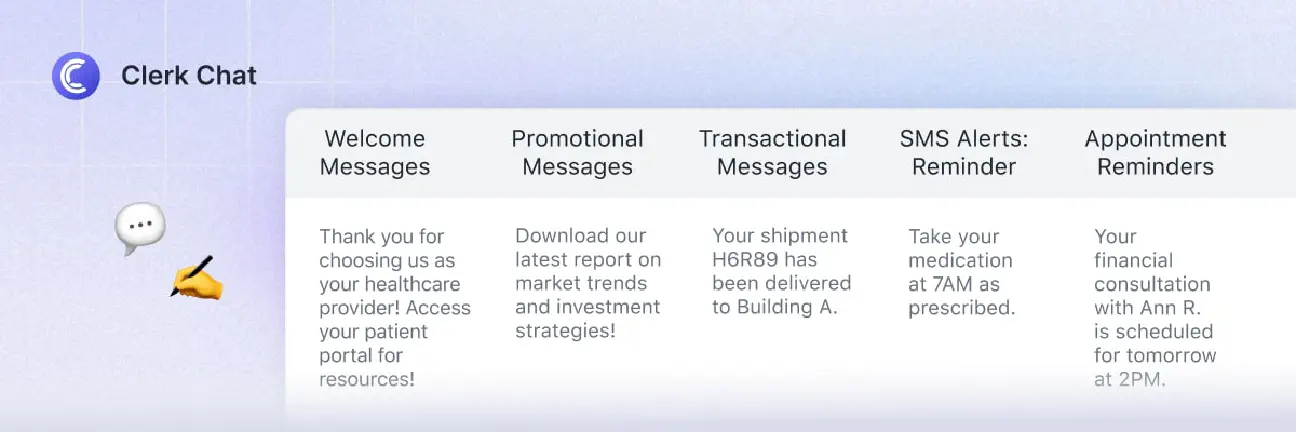RCS vs SMS: How to Know Which is Right for Your Business
By Igor Boshoer
- Published: January 2, 2025
RCS vs SMS: What’s the difference, and which is better for business messaging? For decades, SMS has been the gold standard for fast-paced communication. Since the first text message was sent (Merry Christmas), more than 30 years ago, SMS has taken the world by storm.
Not only do people send billions of texts to friends and loved ones every day, but businesses worldwide use SMS for sales, marketing, and customer service too. But the world of communication is constantly evolving, and now there’s a new player to consider: RCS.
RCS (Rich Communication Services) enables businesses to connect with users in a brand new way, introducing multimedia components and attachments to messages. So, what’s the difference between RCS and SMS, and how do you know which option to use?
In this article:
Defining RCS and SMS: Features, Pros, and Cons
Let’s start with the basics – identifying what both RCS and SMS are, how they work, their unique features – and their distinctive pros and cons.
RCS vs SMS: What is SMS?
SMS stands for “Short Message Service.” It’s the most established and popular form of texting – considered the default way to “message” people worldwide. SMS doesn’t use internet connections to send and receive messages. It sends texts directly through the cellular network, just like a voice call.
SMS relies on a Global System for mobile communications that defines how messages are transferred over carrier networks. SMS can be used for standard conversations, or by businesses sending transactional text messages and promotional content to users.
Companies can also send messages to customers in bulk, using application to person messaging and specific business numbers. An upgraded version of SMS, the Multimedia Messaging Service (MMS), allows for the addition of non-textual content to texts too. Similarly, with MMS, you can send images, audio, and video over a cellular network.
Key features of SMS include:
- Short-form texts: Most messages are 160 characters long
- Universal compatibility: Virtually all mobile phones support SMS
- Plain text: SMS messages are text only (although MMS adds other media)
- Low cost: SMS messages are cost effective for consumers and businesses
- Cellular network: SMS messages are sent through a cellular network (not the internet)
Not sure whether SMS or RCS is right for your business? Ask us about the capabilities of each and find the perfect fit for your needs.
The Pros and Cons of SMS
In the battle of SMS vs RCS, SMS definitely shines as the most accessible, convenient option for messaging. Although it’s a little limited (you can only communicate with words unless you upgrade to MMS), SMS is simple, reliable, and versatile.
Pros:
- Simplicity: Due to character limits, SMS messages are short and direct, which makes them digestible and easy to read – that’s one of the reasons people prefer SMS over email.
- Reach: Virtually all mobile devices support SMS messages, and users don’t need an internet connection to send or receive a text. This gives things like promotional SMS campaigns fantastic reach for businesses.
- Reliable: When you’re choosing between an RCS vs SMS message, it’s worth remembering not all phones support RCS, and those that do require users to have an internet connection. SMS is a lot more reliable, and easier to deliver to a range of audiences.
Cons:
- Character limits: Although character limits can be a good thing, they can make it difficult to convey complex messages properly (without sending multiple texts).
- Media limitations: MMS messages support multimedia attachments – but SMS messages don’t. You’ll be limited in what you can send, even with SMS marketing tools.
- Features: With SMS messages, you don’t get things like typing indicators, read receipts, or delivery notifications built in.

Interactive Demo: Beyond Basic Business Texting
SMS vs RCS: Unpacking Rich Communication Services
RCS stands for Rich Communications Services, and it’s a newer messaging protocol. A lot of mobile carriers are beginning to embrace this messaging service, to enable access to “richer” communication experiences. Using RCS is a lot like using an OTT messaging app, such as iMessage or WhatsApp.
Similar to WhatsApp, RCS uses an internet protocol (IP) connection to enable users to send and receive users, rather than relying on carrier connections. However, in the battle between WhatsApp vs RCS, it’s worth noting that RCS doesn’t require an additional app.
Users can access the service within their phone’s native messaging app – provided it has been enabled. Since RCS is open standard, any device can incorporate the protocol at no extra cost. However, users do need an internet connection to access it.
The key features of RCS include:
- Rich media: Like MMS, RCS supports the sharing of multimedia content such as videos, images, and GIFs within messages. Messages can also include “interactive” elements, like suggested actions, forms, buttons, and reactions.
- No character limit: RCS doesn’t have a specific character limit, so users can send longer messages without having to rely on multiple texts.
- Read receipts and typing indicators: RCS messages show users when someone receives a message, reads it, and even when they’re typing a response.
- Internet connectivity: Similar to iMessage and WhatsApp, RCS messages are sent via cellular data and Wi-Fi connections (not a cellular network).
- Group messaging: RCS offers slightly more features for group messaging than SMS, allowing a larger number of users in a single group.
The Pros and Cons of RCS
When assessing RCS chat vs SMS there are numerous pros and cons to consider. RCS might not have the reach or accessibility of SMS, but it does give users more interactive features, and more unique ways to interact with contacts.
Pros:
- Multimedia support: RCS makes it easy to fill your texts with various types of content, from links, to images, videos, GIFs, and more.
- Unique features: Compared to SMS, RCS offers more unique features, such as support for longer messages, read receipts, and typing indicators – which are great for conversational messaging and group conversations.
- Encryption: SMS compliance can be difficult to master due a lack of security built into the messaging protocol. However, GSMA is working to make RCS end-to-end encrypted (although this feature isn’t fully available yet).
- Verified senders: With business messaging for RCS, users can create verified sender profiles which allow them to share their logo and business details with customers.
Cons:
- Reach and adoption: Not all carriers support RCS yet, and this form of messaging requires more modern smartphones and access to the internet, which limits its reach.
- Complexity: Though RCS offers more features, this can lead to increased complexity for businesses and users creating campaigns.
- Cost: When it comes to using RCS for business messaging, RCS may cost more per message to implement into marketing campaigns.
What’s the Difference Between RCS and SMS?
So, RCS vs SMS: what are the biggest differences? There are actually quite a few, so let’s break them down side-by-side, so they’re easier to digest.
| Feature | SMS | RCS |
|---|---|---|
| Network dependency | SMS sends messages over a cellular network and doesn’t require any access to an internet connection. | RCS relies on an internet protocol, which means it needs a phone to have access to the internet to send and receive messages. |
| Functionality | SMS is only for text-based messages and has a strict character limit of up to 160 characters. | RCS supports a range of multimedia options, including video, images, GIFs, and audio recordings, and it has no strict character limit. |
| Delivery | With SMS, you can reach people all over the world, but you won’t get any confirmation that they’ve actually received your message. | With RCS, you can connect with fewer potential contacts, but you’ll be able to see when a message has been received and when someone is typing a response. |
| Compatibility | Any phone (smart or mobile) can potentially receive SMS messages. You can even send SMS to a landline in some cases. | Only smart phones with internet connections can actually receive and send RCS. |
| Integrations | Although SMS uses carrier networks for sending and receiving messages, applications with other services depend on platforms. | Since RCS uses IP, like a lot of other applications, it allows for easy integration with a range of messaging services. |
| Security | There’s no native encryption available for SMS messages. So, if you’re using SMS for business communication, you’ll need to be cautious about compliance. | RCS can support end-to-end encryption, but the level of security available depends on the carrier offering the service. |
How Does RCS Compare to Other Messaging Formats?
So, you know the difference between SMS vs RCS, but how does RCS compare to other messaging formats, like iMessage, WhatsApp, or even MMS? First of all, RCS is pretty similar to iMessage and WhatsApp, as well as other OTT messaging applications.
The biggest difference between an RCS message vs an iMessage is that iMessages are specific to Apple phones and Apple’s dedicated messaging service. RCS can be accessed on potentially any device. Beyond that, the two options have very similar features, such as support for multiple forms of media, read receipts, and typing indicators.
Compared to the likes of WhatsApp, Facebook Messenger, and Telegram, RCS is a slightly simpler solution that doesn’t require the use of a third-party app. You also don’t need to create an account with a particular vendor to use RCS texting.
Compared to MMS, the major difference is that RCS texting supports read receipts, typing indicators, and longer character counts. In the battle of RCS vs MMS, RCS can also be a slightly better option for group messaging, due to the option to add more people into a group.
Plus, MMS still relies on carrier networks to send and receive messages, just like SMS, while RCS uses internet protocol – as mentioned above.


Why RCS May Outshine SMS
A lot of people assume that RCS will soon overtake SMS as the “standard messaging format,” simply because it offers more features than SMS. However, that’s probably not going to be the case. The simple reason for this is that the accessibility and availability of RCS is still limited.
First, the availability and capabilities of RCS depend on the support of a carrier, and the implementation model of the provider. Not all carriers support RCS – although a lot of major US carriers do support the protocol. However, even if a carrier does support RCS, the features available to users will depend on the implementation model chosen by the provider.
For instance, Android users can access RCS and enable or disable features within their settings. However, Apple was reluctant to introduce RCS to its messaging system until recently.
Beyond that, there’s the issue of internet dependency to consider. RCS requires an internet connection through Wi-Fi or mobile data. Although most smartphone users have access to the internet today, there are still areas throughout the world where connectivity is limited.
For companies investing in this messaging protocol, this could mean it’s harder to reach the same number of customers with RCS marketing messages, compared to SMS.
The Future of RCS for Mobile Messaging
Despite its limitations, RCS has a lot to offer, particularly for business messaging. It enables access to better insights from B2C and B2B text messaging campaigns – allowing companies to track engagement.
Additionally, since RCS supports more forms of media, as well as buttons, forms, and attachments, it can allow for the creation of more engaging marketing campaigns. Alternatively, the limited capabilities of SMS mean it usually works better for transactional messages, while most companies switch to MMS for marketing strategies.
As RCS accessibility evolves (currently about 1 billion people have access to this messaging format), adoption of RCS will continue to grow. Already, many major players like T-Mobile, Sprint, and AT&T have implemented the messaging format, and more people are taking note worldwide.
Companies in certain industries may even choose to embrace RCS because of the extra benefits it offers in terms of security. As mentioned in our previous comparison of SMS vs RCS, encryption is set to be a powerful feature of RCS business messaging in the years ahead. Plus, companies can already create “verified sender” accounts that can help them earn the trust of their target audience.
Despite this, RCS still has a long way to go before it can replace SMS entirely. Although the features offered by SMS haven’t changed much over the years, the way companies can leverage SMS workflows has evolved, thanks to intuitive messaging apps like Clerk Chat.
Companies can even use SMS for AI-based customer experience strategies, by embedding AI-powered tools into their messaging platforms. Plus, SMS will, at least for now, remain the best way to reach the widest portion of the world’s population – wherever they might be.
Not sure whether SMS or RCS is right for your business? Ask us about the capabilities of each and find the perfect fit for your needs.
RCS Message vs SMS: Which is Better for Business?
So, RCS vs SMS: which will propel your business forward?
Ultimately, that all depends on your needs. Both RCS and SMS have a lot to offer companies in a wide range of industries, regardless of whether they’re looking to support internal communication or update their customer communication strategies.
SMS Could Be the Better Option for:
- Exceptional reach: Since SMS is supported by all mobile phones and carriers, you won’t have to worry about reaching your audience with SMS. The biggest hurdle to overcome will be choosing the right number (such as a 10 digit long code) for marketing.
- Instant communication: Even if multiple carriers support RCS, you can’t always guarantee the people you want to reach will have the internet connection they need to receive your messaging. A2P 10DLC messaging ensures you can reach customers instantly.
- Simplicity: If you don’t necessarily need to send complicated messages brimming with different types of media, SMS is the better option. It’s definitely the more cost-effective option for sending simple messages in bulk.
RCS Could Be the Better Option for:
- Engaging messages: If you want to upgrade your SMS marketing strategy with rich media, forms, and buttons, then RCS is the better option. It gives you more ways to create interactive text messages that could lead to higher conversion rates.
- Improving security: Although you’ll still need to adhere to regulations like the CAN-SPAM act with RCS texts, you could face fewer security issues thanks to integrated encryption features, and verified sender profiles.
- Enabling integrations: If you want to use RCS alongside other tools, such as your CRM or your conversational AI for customer service, RCS makes integrations easy to enable.
RCS vs SMS: Do You Really Have to Choose?
Ultimately, RCS and SMS both have their strengths and limitations. The best way to create the ultimate messaging strategy is to combine the two. With a platform like Clerk Chat, you can leverage both SMS and RCS at the same time, as well as MMS and conversational AI for sales teams, service teams, marketers, and more.
With an all-in-one platform, you can use SMS for fast-paced transactional messages, notifications, appointment reminders and updates, ensuring you can reach your customers anywhere. Then, you can switch to RCS when you want to create more interactive, engaging multi-media messages.
You can even combine both messaging strategies with other communication options, like VoIP and video through Clerk Chat’s integration with Microsoft Teams, or WhatsApp for OTT messaging.
Ultimately, the question isn’t whether RCS or SMS is better, it’s which option is “best” for your specific needs. Give yourself the freedom to choose both with Clerk Chat.
An innovator by nature, Igor is dedicated to translating the technical aspects of product development into actionable business strategies and sales growth. He thrives when building scalable infrastructures while leading global teams to success. In his free time he indulges in his passions for film, mathematics, and engineering. Find his tech expertise in films like The Wolf of Wall Street.
In this article:
- Defining RCS and SMS: Features, Pros, and Cons
- Interactive Demo: Beyond Basic Business Texting
- SMS vs RCS: Unpacking Rich Communication Services
- The Pros and Cons of RCS
- What’s the Difference Between RCS and SMS?
- How Does RCS Compare to Other Messaging Formats?
- Why RCS May Outshine SMS
- The Future of RCS for Mobile Messaging
- RCS Message vs SMS: Which is Better for Business?
- RCS vs SMS: Do You Really Have to Choose?
Ready to use your business number for text messaging?
Thousands of businesses are already experiencing the power of conversational messaging through SMS. Join us. Free trial and paid tiers available.
Get Started#Subscribe
Get product updates in your inbox
Tutorials, features, and Clerk Chat news delivered straight to you.




